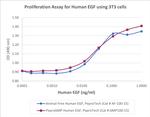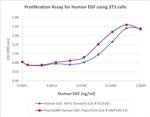Search Thermo Fisher Scientific
FIGURE: 1 / 2
PeproGMP® Human EGF Protein (GMP100-15-100UG) in Functional


Product Details
GMP100-15-100UG
Species
Published species
Expression System
Amino acid sequence
Molecular weight
Class
Type
Purity
Endotoxin concentration
Activity
Conjugate
Form
Purification
Contains
Storage conditions
Shipping conditions
Product Specific Information
Additional product information and specifications are provided on the Certificate of Analysis.
All PeproGMP® products are manufactured using animal-derived component free materials.
Product Description/Intended Use: PeproTech GMP recombinant proteins are manufactured for use as ancillary materials by applying applicable principles of GMP and quality control requirements from USP (United States Pharmacopeia) Chapter <1043> Ancillary Materials for Cell, Gene, and Tissue-Engineered Products.
Product use statement: For research use or further manufacturing. Not for diagnostic use or direct administration into humans or animals.
Target Information
EGF (Epidermal growth factor) exerts its actions by binding to the EGF Receptor, a 170 kDa protein kinase. Activation of EGFR initiates diverse cellular pathways in response to toxic environmental stimuli, or to EGF binding to the receptor, the EGFR forms homo- or heterodimers with other family members. Each dimeric receptor complex initiates a distinct signaling pathway by recruiting different Src homology 2 (SH2) containing effector proteins. EGF is far and wide expressed in kidney, cerebrum, prostrate and salivary glands. EGF acts as a potent mitogenic factor and the phosphorylated receptor recruits adapter proteins like GRB2 that activates complex downstream signaling cascades. EGF activates at least 4 major downstream signaling cascades including the RAS-RAF-MEK-ERK, PI3 kinase-AKT, PLCgamma-PKC and STAT modules. Research studies suggest the protein may also play important role in activating the NF-kappa-B signaling cascade. Defects in the EGGF gene are the cause of hypomagnesemia type 4 and dysregulation has been associated with the growth and progression of certain cancers.
For Research Use Only. Not for use in diagnostic procedures. Not for resale without express authorization.
Bioinformatics
Protein Aliases: beta-urogastrone; EGF; H-EGF; Pro-epidermal growth factor
Gene Aliases: EGF; HOMG4; URG
UniProt ID: (Human) P01133
Entrez Gene ID: (Human) 1950

We're here to help
Get expert recommendations for common problems or connect directly with an on staff expert for technical assistance related to applications, equipment and general product use.
Contact tech support
